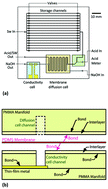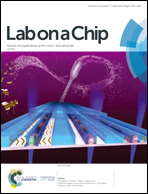Long-term hydrolytically stable bond formation for future membrane-based deep ocean microfluidic chemical sensors
Abstract
Future ocean profiling of dissolved inorganic carbon and other analytes will require miniaturised chemical analysis systems based on sealed gas membranes between two fluid channels. However, for long-term deployment in the deep ocean at high pressure, the ability to seal incompatible materials represents an immense challenge. We demonstrate proof of principle high strength bond sealing. We show that polydimethylsiloxane (PDMS) is a preferred membrane material for rapid CO2 transfer, without ion leakage, and report long-term stable bonding of thin PDMS membrane films to inert thermoplastic poly(methyl methacrylate) (PMMA) patterned manifolds. Device channels were filled with 0.01 M NaOH and subjected to repeated tape pull and pressure – flow tests without failure for up to six weeks. Bond formation utilised a thin coating of the aminosilane bis-[3-trimethoxysilylpropyl]amine (BTMSPA) conformally coated onto PMMA channels and surfaces and cured. All surfaces were subsequently plasma treated and devices subject to thermocompressive bond annealing. Successful chemically resistant bonding of membrane materials to thermoplastics opens the possibility of remote environmental chemical analysis and offers a route to float-based depth profiling of dissolved inorganic carbon in the oceans.



 Please wait while we load your content...
Please wait while we load your content...
